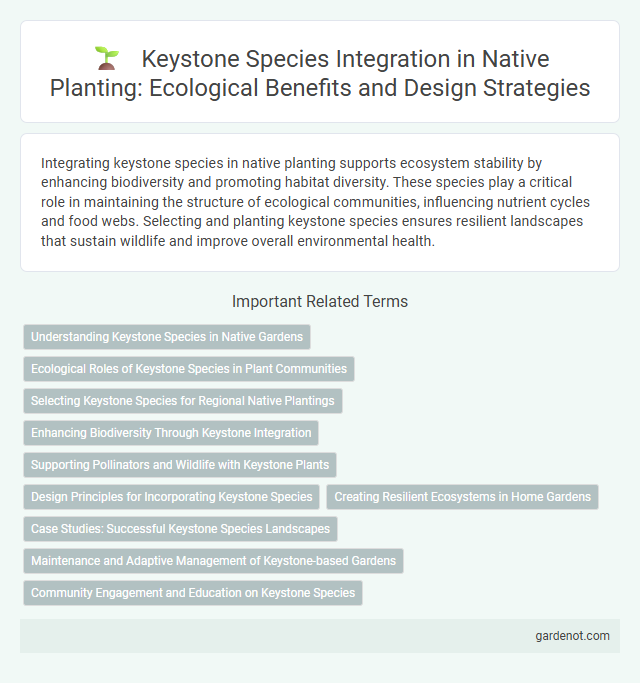Integrating keystone species in native planting supports ecosystem stability by enhancing biodiversity and promoting habitat diversity. These species play a critical role in maintaining the structure of ecological communities, influencing nutrient cycles and food webs. Selecting and planting keystone species ensures resilient landscapes that sustain wildlife and improve overall environmental health.
Understanding Keystone Species in Native Gardens
Keystone species play a critical role in maintaining the structure and health of native gardens by supporting biodiversity and ecosystem stability. Integrating species such as oak trees, which provide habitat and food for numerous insects, birds, and mammals, enhances pollination and natural pest control. Understanding the ecological functions of these keystone plants allows gardeners to create more resilient and self-sustaining native landscapes.
Ecological Roles of Keystone Species in Plant Communities
Keystone species in native planting play a crucial role in maintaining the structure and function of plant communities by regulating population dynamics and promoting biodiversity. Their presence influences nutrient cycling, soil health, and habitat availability, creating a resilient ecosystem that supports various flora and fauna. Integrating keystone species such as oaks, willows, and mycorrhizal fungi enhances ecosystem stability and productivity in restoration projects.
Selecting Keystone Species for Regional Native Plantings
Selecting keystone species for regional native plantings involves identifying plants that play a crucial role in maintaining ecosystem structure and function, such as oak trees in eastern North American forests or elderberry in Pacific Northwest wetlands. These species support diverse wildlife by providing essential resources like food, habitat, and pollinator support, thereby enhancing biodiversity and ecosystem resilience. Integrating keystone species tailored to local environmental conditions and soil types maximizes restoration success and long-term ecological balance.
Enhancing Biodiversity Through Keystone Integration
Integrating keystone species into native planting schemes significantly enhances biodiversity by stabilizing ecosystem functions and promoting species diversity. Keystone species such as oaks and beavers create habitats that support a wide range of flora and fauna, fostering ecological balance. Their presence in native plant communities boosts resilience against environmental disturbances and encourages the proliferation of native wildlife populations.
Supporting Pollinators and Wildlife with Keystone Plants
Keystone species like milkweed, goldenrod, and coneflower play a critical role in supporting pollinators and wildlife by providing essential nectar, pollen, and habitat. Integrating these native plants in landscaping enhances biodiversity and sustains critical food webs, benefiting bees, butterflies, and birds. Incorporating keystone plants strengthens ecosystem resilience and promotes long-term environmental health.
Design Principles for Incorporating Keystone Species
Incorporating keystone species into native planting designs enhances ecosystem stability by prioritizing species that regulate key ecological processes, such as predation or nutrient cycling. Design principles emphasize selecting native keystone plants that support local wildlife, promote biodiversity, and maintain habitat structure. Strategic placement and diversity of these species ensure resilience against environmental stressors and foster sustainable, self-regulating plant communities.
Creating Resilient Ecosystems in Home Gardens
Integrating keystone species such as native oaks and pollinator-friendly plants strengthens home garden ecosystems by supporting diverse wildlife and enhancing soil health. These foundational plants foster natural pest control and improve water retention, promoting sustainability in residential landscapes. Strategic inclusion of keystone species creates resilient, self-sustaining gardens that thrive amid environmental challenges.
Case Studies: Successful Keystone Species Landscapes
Case studies of Keystone species integration in native planting highlight ecosystems where species like the American beaver and sea otter restored ecological balance by engineering habitats and controlling prey populations, promoting biodiversity. These landscapes demonstrate increased native plant diversity and improved soil health, directly linked to the keystone species' activities. Effective keystone species integration supports resilience, enhances ecosystem functions, and facilitates habitat restoration in native planting projects.
Maintenance and Adaptive Management of Keystone-based Gardens
Maintenance of keystone species in native planting requires regular monitoring of plant health and soil conditions to ensure ecosystem stability. Adaptive management involves adjusting watering schedules, pruning techniques, and pest control methods based on seasonal changes and species-specific needs. Integrating keystone species enhances biodiversity, supports pollinators, and fosters resilience against environmental stressors.
Community Engagement and Education on Keystone Species
Integrating keystone species into native planting projects enhances ecosystem stability by supporting biodiversity and ecological balance. Community engagement initiatives, such as workshops and citizen science programs, empower residents to identify and nurture keystone species in local habitats, fostering environmental stewardship. Educational campaigns focusing on the critical roles of keystone species promote awareness and inspire sustainable conservation practices within the community.
Keystone species integration Infographic

 gardenot.com
gardenot.com